Understanding Fruit on the Keto Diet
The ketogenic diet works by drastically reducing carbohydrate intake and replacing it with fat, putting your body into a metabolic state called ketosis. In this state, your body becomes incredibly efficient at burning fat for energy instead of carbohydrates. While most fruits are naturally sweet and contain significant amounts of carbohydrates, certain low-sugar options can be enjoyed in moderation without disrupting ketosis.
Choosing the right fruits is essential for maintaining ketosis on a keto diet
When selecting fruits on keto, focus on net carbs rather than total carbs. Net carbs are calculated by subtracting the fiber content from the total carbohydrates, as fiber doesn’t significantly impact blood sugar levels or ketosis. This calculation helps you determine which fruits can fit within your daily carb limit while still providing essential nutrients.
Keto-Friendly Fruits You Can Enjoy
These low-carb fruits can be incorporated into a ketogenic diet in moderate amounts. Pay close attention to serving sizes to ensure you stay within your daily carb limit.
| Fruit | Serving Size | Net Carbs | Total Carbs | Fiber |
| Avocado | 1/2 medium (100g) | 1.8g | 8.5g | 6.7g |
| Raspberries | 1/2 cup (62g) | 3.3g | 7.0g | 3.7g |
| Blackberries | 1/2 cup (72g) | 3.1g | 7.0g | 3.9g |
| Strawberries | 1/2 cup (72g) | 3.3g | 5.5g | 2.2g |
| Olives | 10 large (40g) | 0.9g | 2.7g | 1.8g |
| Star Fruit | 1/2 cup (66g) | 2.6g | 4.4g | 1.8g |
| Tomatoes | 1 medium (123g) | 3.3g | 4.8g | 1.5g |
| Watermelon | 1/2 cup (76g) | 5.4g | 5.9g | 0.5g |
Avocados: The Perfect Keto Fruit
Avocados are arguably the ideal keto fruit due to their high fat content and minimal net carbs. Half an avocado contains only 1.8g of net carbs while providing 15g of healthy fats and 6.7g of fiber. They’re rich in potassium, which helps manage the electrolyte balance that’s often disrupted during ketosis. Add avocados to salads, make guacamole, or simply enjoy with a sprinkle of salt and pepper.
Berries: Small but Mighty
Berries offer the best balance of sweetness and low carb content among traditional fruits. Raspberries and blackberries are particularly keto-friendly, with about 3g of net carbs per half-cup serving. They’re packed with antioxidants that help reduce inflammation and protect against disease. Strawberries are slightly higher in carbs but still manageable in small portions. Enjoy berries with heavy cream, in smoothies, or as a topping for keto pancakes.
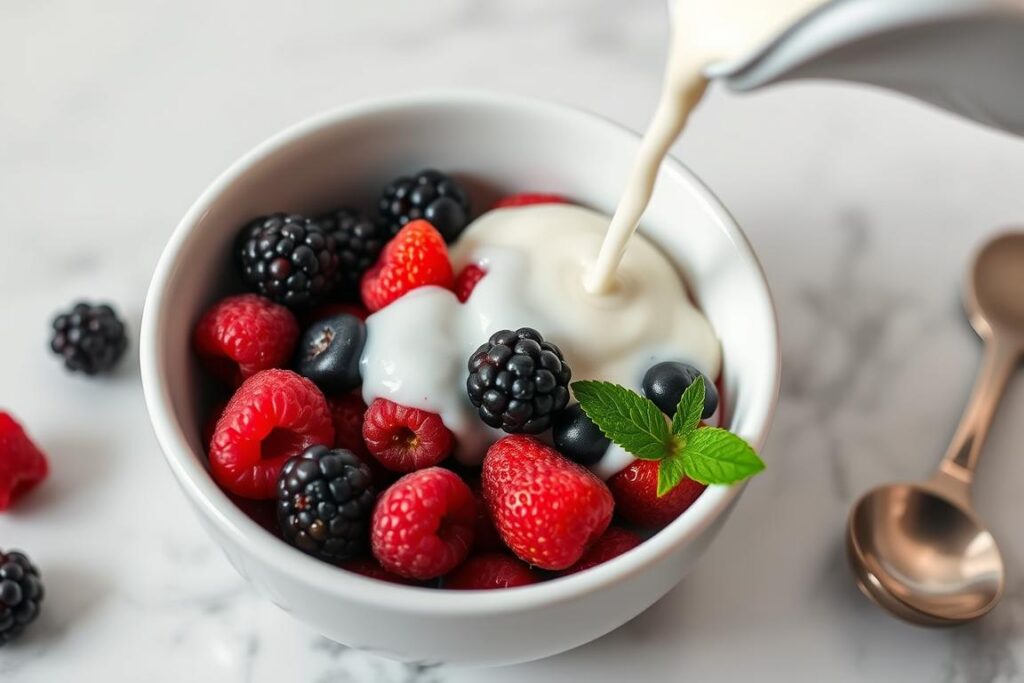
Berries with heavy cream make a delicious keto-friendly dessert
Olives: Savory Fruit Option
Though often thought of as a vegetable, olives are technically a fruit and perfect for keto with less than 1g of net carbs per 10 olives. They’re rich in monounsaturated fats and antioxidants like vitamin E. Olives make an excellent snack on their own or can be added to salads and keto Mediterranean dishes.
Other Low-Carb Fruits
Several other fruits can be enjoyed in moderation on keto:
- Star fruit (carambola): With its distinctive shape and only 2.6g net carbs per half cup
- Tomatoes: Technically a fruit with just 3.3g net carbs per medium tomato
- Watermelon: Higher in carbs but can be enjoyed in small portions (5.4g net carbs per half cup)
- Cantaloupe: About 5.8g net carbs per half cup, offering a sweet treat in small amounts
- Plums: One small plum contains approximately 6.6g net carbs
Fruits to Avoid on the Keto Diet
While some fruits can fit into a ketogenic lifestyle, many popular options are too high in carbohydrates to be keto-compatible. These high-sugar fruits can quickly use up your daily carb allowance and potentially kick you out of ketosis.
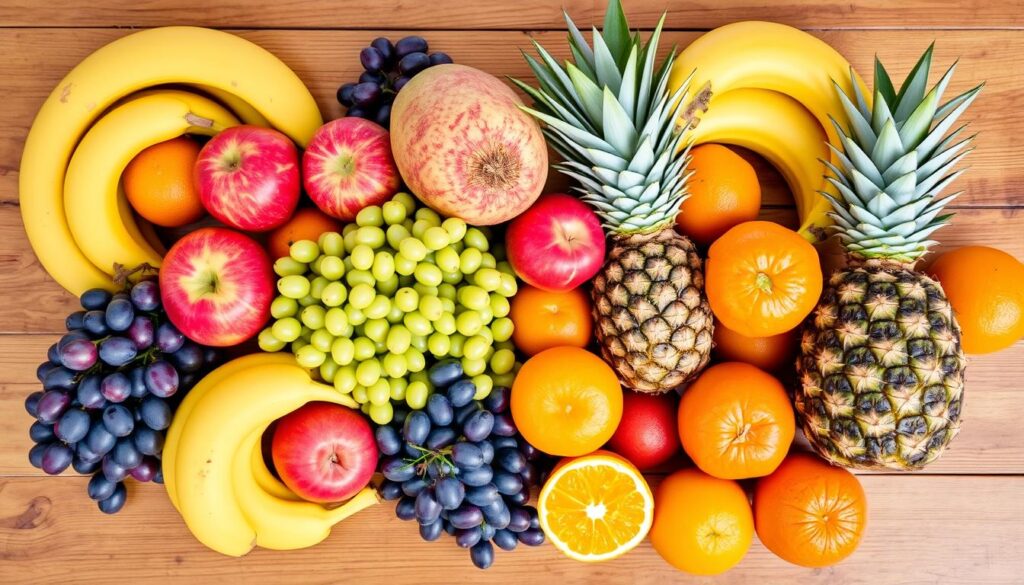
These high-carb fruits can quickly exceed your daily carb limit on keto
| Fruit | Serving Size | Net Carbs | Why Avoid |
| Banana | 1 medium (118g) | 24g | A single banana exceeds most people’s daily carb limit on keto |
| Apple | 1 medium (182g) | 21g | Contains high amounts of fructose that can disrupt ketosis |
| Mango | 1 cup (165g) | 22g | Extremely high in natural sugars |
| Grapes | 1 cup (151g) | 26g | Small size makes it easy to overconsume |
| Pineapple | 1 cup (165g) | 19g | Very high in natural sugars |
| Orange | 1 medium (131g) | 12g | Moderately high in carbs; better alternatives available |
Why These Fruits Disrupt Ketosis
High-carb fruits can impact ketosis in several ways:
- They cause rapid blood sugar spikes that can interrupt fat-burning
- The high fructose content is processed by the liver and can refill glycogen stores
- They can trigger cravings for more sweet foods
- A single serving can use up most or all of your daily carb allowance
Additionally, fruit juices and dried fruits are even more concentrated sources of sugar and should be completely avoided on a ketogenic diet. Even a small glass of orange juice can contain over 20g of net carbs, while a handful of raisins packs around 22g of net carbs.
Tips for Incorporating Fruit on Keto
With careful planning, you can enjoy fruits on a ketogenic diet without compromising your metabolic state. Here are practical strategies for including fruit in your keto meal plan:
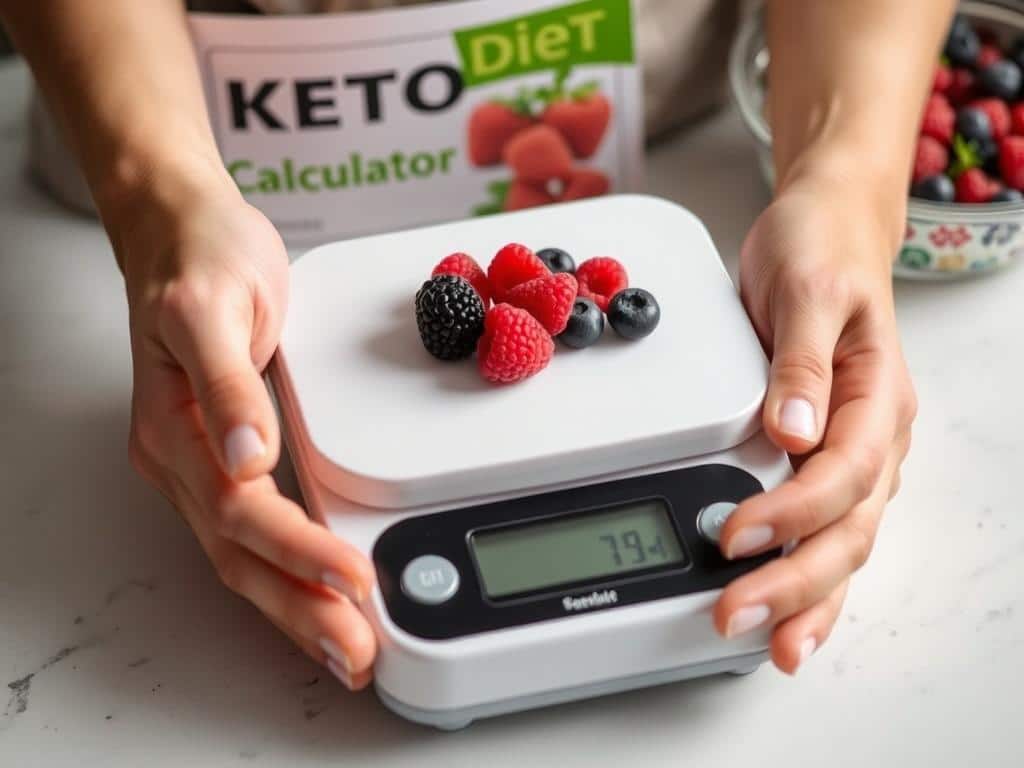
Measuring portions is crucial for including fruit in your keto diet
Practice Portion Control
The most important strategy for enjoying fruit on keto is strict portion control. Consider these approaches:
- Use a food scale to measure exact portions
- Pre-portion berries into small containers for grab-and-go snacks
- Think of fruit as a garnish rather than a main component of meals
- Track your intake in a food diary or app to ensure you stay within limits
Balance Your Macros
If you plan to include fruit in your diet, adjust other sources of carbohydrates accordingly:
- Reduce carbs from other sources on days you consume fruit
- Pair fruits with high-fat foods like cheese or nuts to slow sugar absorption
- Consider a slightly higher carb allowance (30-50g) if you’re very active
- Save fruit for pre-workout consumption when your body can utilize the carbs more efficiently
Strategic Timing
When you consume fruit can impact how it affects ketosis:
- Eat fruit earlier in the day to allow time for the body to use the carbs
- Consider fruit as a pre-workout energy source
- Avoid fruit before bedtime when metabolism naturally slows
- Space out fruit consumption rather than eating all your fruit at once
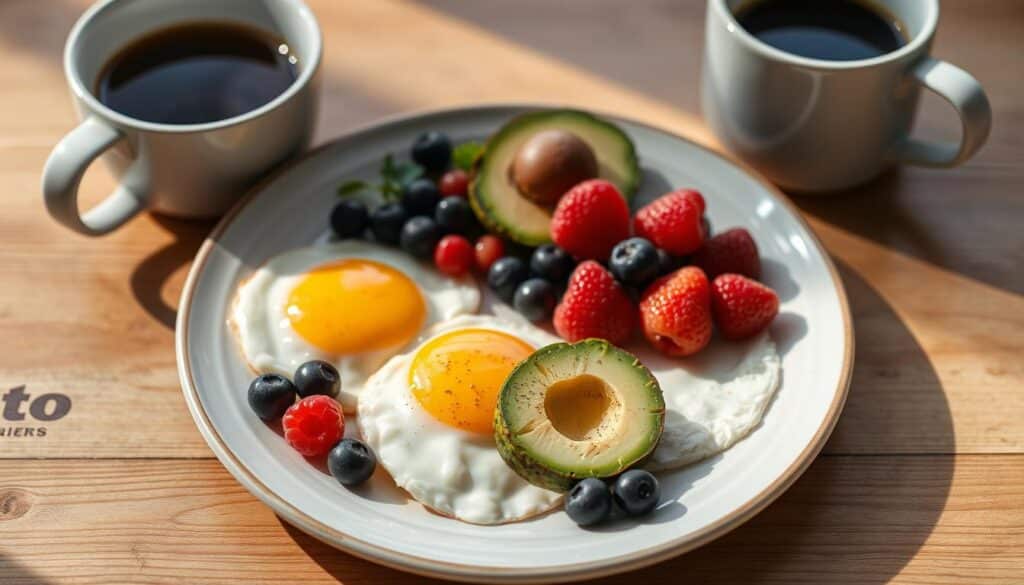
Including small portions of berries with a high-fat breakfast minimizes blood sugar impact
Keto-Friendly Alternatives to High-Carb Fruits
When fruit cravings strike but you need to keep carbs low, consider these alternatives that can satisfy your sweet tooth without disrupting ketosis:
Keto-Approved Sweeteners
Natural sweeteners can help satisfy cravings without the carb impact:
- Stevia – Zero-carb plant-based sweetener
- Erythritol – Sugar alcohol with minimal impact on blood sugar
- Monk fruit – Natural sweetener with antioxidant properties
- Allulose – Rare sugar that doesn’t count toward net carbs
Flavor Enhancers
Add fruit-like flavors to foods without the carbs:
- Extracts – Vanilla, almond, lemon, and other natural extracts add flavor without carbs
- Spices – Cinnamon, nutmeg, and cardamom can add sweetness perception
- Citrus zest – Provides intense flavor with minimal carbs
- Herbal teas – Fruit-flavored teas can satisfy cravings without carbs

Keto-friendly alternatives can satisfy fruit cravings without exceeding carb limits
Vegetable Substitutes
Some vegetables can provide similar nutritional benefits with fewer carbs:
- Bell peppers – Sweet and crunchy with fewer carbs than apples
- Cucumber – Refreshing alternative to melon
- Zucchini – Can be spiralized for a pasta-like texture
- Rhubarb – Tart flavor similar to some fruits (needs keto sweetener)
Keto Dessert Options
Satisfy sweet cravings with these keto-friendly treats:
- Whipped cream with a few berries
- Coconut cream pudding
- Dark chocolate (85% or higher cacao)
- Chia pudding made with unsweetened almond milk
Frequently Asked Questions About Fruit on Keto
How many strawberries can I eat on keto?
On a standard keto diet with 20g net carbs daily, you can enjoy about 8-10 medium strawberries (approximately 1 cup), which contains around 6-7g net carbs. If you’re following a more liberal low-carb approach (30-50g net carbs), you can include more. Always measure and track your portions to ensure you stay within your personal carb limit.
Is tomato allowed on keto?
Yes, tomatoes are allowed on keto in moderation. While technically a fruit, tomatoes are relatively low in carbs compared to other fruits. A medium tomato (123g) contains about 4.8g total carbs and 1.5g fiber, resulting in 3.3g net carbs. Cherry tomatoes are even more keto-friendly, with about 4g net carbs per cup. Tomatoes can be included in salads, sauces (in moderation), and as a topping for keto dishes.
Will eating fruit kick me out of ketosis?
It depends on the type and amount of fruit you consume. High-sugar fruits like bananas, apples, and mangoes can easily kick you out of ketosis even in small amounts. However, small portions of low-carb fruits like berries, avocados, and olives can fit into your daily carb allowance without disrupting ketosis. The key is monitoring your total daily net carb intake and staying within your personal threshold (typically 20-50g per day).
Can I eat fruit on a cyclical keto diet?
Yes, cyclical keto diets (CKD) include planned higher-carb periods, typically 1-2 days per week, where you can incorporate more fruits. During these “carb-up” days, you can enjoy moderate amounts of higher-carb fruits like apples, oranges, or pineapple. However, during standard keto days, you should still limit fruit to low-carb options. This approach is most commonly used by athletes and very active individuals who need periodic glycogen replenishment.
Are frozen berries keto-friendly?
Frozen berries have virtually the same nutritional profile as fresh berries, making them equally keto-friendly. In fact, frozen berries can be more convenient for portion control, as you can take out exactly what you need without worrying about spoilage. Just be sure to check the label and avoid products with added sugar. Frozen berries work well in smoothies, desserts, or thawed and topped with heavy cream for a quick keto treat.

Monitoring ketone levels can help determine how fruit affects your personal ketosis threshold
Start Your Keto Journey Today
Download our free 7-day keto meal plan featuring delicious recipes with low-carb fruits.
Enjoying Fruit on Keto: The Bottom Line
Yes, you can eat fruit on the keto diet, but careful selection and portion control are essential. Focus on low-carb options like berries, avocados, and olives while avoiding high-sugar fruits such as bananas, apples, and tropical varieties. Always calculate net carbs (total carbs minus fiber) and track your daily intake to ensure you stay within your carb limit.
Remember that individual responses to carbohydrates vary. Some people can maintain ketosis with up to 50g of net carbs daily, while others need to stay below 20g. Consider testing your ketone levels after consuming fruit to understand your personal threshold. With mindful consumption, you can enjoy the nutritional benefits and flavors of select fruits while maintaining your ketogenic lifestyle.
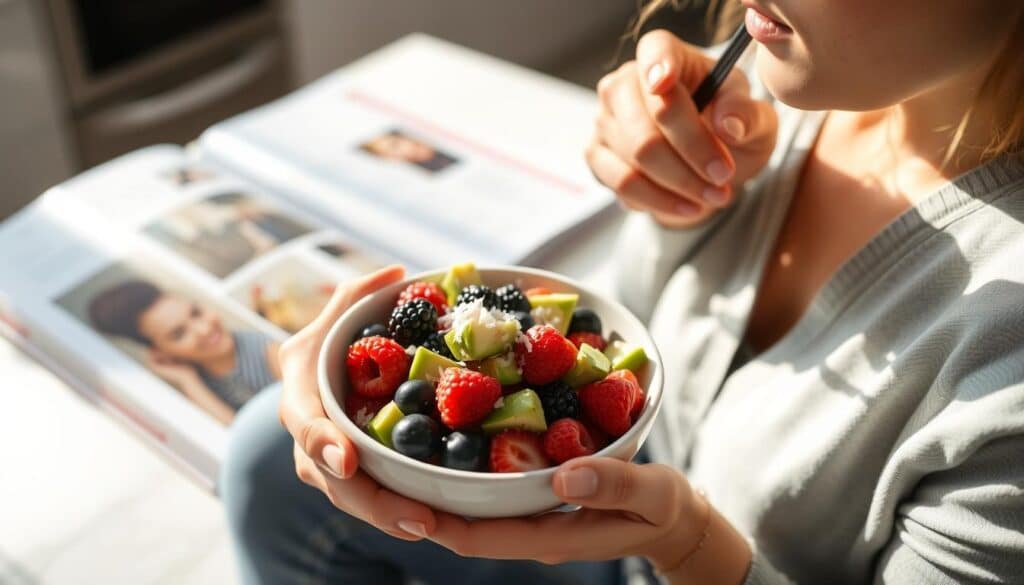
With proper planning, you can enjoy the nutritional benefits of select fruits while maintaining ketosis
The ketogenic diet doesn’t have to mean completely eliminating fruit from your life. By making informed choices and practicing moderation, you can satisfy fruit cravings while staying on track with your low-carb lifestyle. Focus on nutrient density, portion control, and balance to create a sustainable approach to keto that includes small servings of nature’s sweet treats.
Get Your Free Keto Fruit Guide
Download our printable guide with complete net carb counts for all fruits, plus serving size recommendations to stay in ketosis.
Plan Your Keto Meals with Ease
Our interactive meal planner helps you incorporate fruits into your keto diet while staying within your daily carb limit.

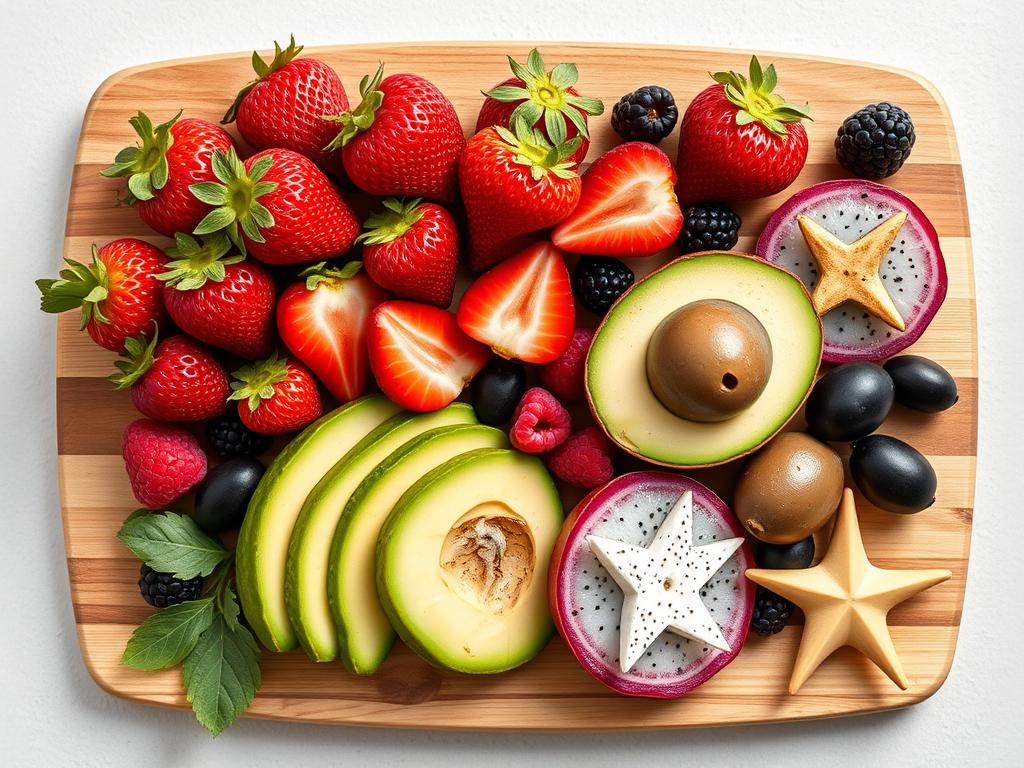

1 thought on “Can You Eat Fruit on the Keto Diet?”